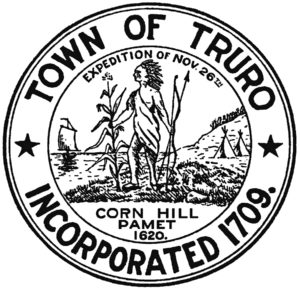Last December, the Independent published the first in a series of articles on town seals of the Outer Cape. The iconography on these seals, created more than a century ago, is largely inaccurate and offensive to many Native Americans.
This investigation began because of ongoing discussions about the state flag and seal in Massachusetts. On Jan. 11, Gov. Charlie Baker signed a bill establishing a commission to change the state flag and seal. The commission must complete its work by Oct. 1 of this year. Article 16 on the warrant for the 2021 Truro Annual Town Meeting supports the formation of this state commission.

The Truro Historical Society wants to see a Native peoples committee established with several possible objectives, including redesigning the Truro town seal, which was designed by Edward A. Wilson, one of the founders of the society. Annawon Weeden, a member of the Mashpee Wampanoag tribe, and Truro Central School teacher Lynne Ready have already volunteered to serve.
Among town seals, Helen McNeil-Ashton told the select board on March 16, “Ours is better than a lot of them, but it does depict a Wampanoag wearing a Plains Indian war bonnet and standing next to a teepee with a text that celebrates the theft of corn.” McNeil-Ashton is the historical society’s vice president of collections. “For the time being,” she said, “these are only symbolic actions, but symbolic actions reflect social values and influence future social values.”
The society wants the new group to be a subcommittee of the Truro Historical Commission, an official town board. The commission met on April 6 and discussed how a Native peoples committee might be created. Susan Areson, the select board’s liaison to the historical commission, stressed that the commission already has a large number of subcommittees with many vacancies.
McNeil-Ashton argued that having the committee be part of the historical commission would lend it gravitas. She also said it was important that “the town takes responsibility for its history.” Both commission chair Matt Kiefer and vice chair Chuck Steinman, however, felt the committee would be less encumbered if it were separate from the commission.
An important consideration is ensuring Truro nonresidents can serve on the committee — there are very few Native people living in town.
In Wellfleet and Eastham, whose town seals most need fixing, not much is happening yet. (Provincetown’s town seal has no Native iconography.) Thomas Ryan, vice chair of Eastham 400, told the Independent that he has been meaning to do something about the seal. With a background in liturgical iconography, he understands the power of the image. But, at the moment, the “town seal feels like it can wait.” Ryan, a former Catholic priest, is busy advocating for Covid vaccinations for undocumented Brazilians. (Ryan is a shareholder of the Provincetown Independent.)

He said that “these four towns will need to invent” a way of dealing with the town seal situation. “We don’t do this that often. The exact route will differ by town.” His advice was to skip the historical commission and select board and go straight to town meeting, where people will be most “simpatico.”
The town of Mashpee, which is redesigning its seal, could serve as a model. David Weeden is the chair of an ad hoc town seal committee there. He is also a Mashpee selectman and sits on the Mashpee Wampanoag Tribal Council. His nephew, Brian Weeden, who sits on the town’s historical and conservation commissions, initiated a town seal article for the 2019 town meeting.
The Mashpee Town Seal Committee is creating a community survey and is working with local graphic design companies, with hopes to be done by May 2022. “For us, the question was, do we want to change it in its entirety, or revise what’s there,” said Weeden. “That question was posed, and it seemed, collectively, folks wanted to start from scratch.” He added that “at the state level, there should be a larger Native American committee that looks at each individual seal as an advisory committee.”
What should actually go on the seals? Linda Coombs, a Wampanoag historian who advised the Wellfleet Historical Society on its exhibit “Before 1620? Who Was Here,” said, “It would be nice if it somehow incorporated the people of the land they’re on, [in a way] that’s accurate.” She felt it wasn’t important that a Native American artist design the seals, however. “As long as there’s an indigenous person involved in the process, it’s OK,” Coombs said.
Robert Peters, a Mashpee Wampanoag artist who lives in Mattapan, had more specific ideas. He offered his own painting, Punkhorn Point, which shows Mashpee in 1976. “If it were me, that’s the first image that would come to mind,” he said. “It honors the Native aspect and also the environment — the way of life for a fisherman.”
His art puts Native peoples “in the light of now, the not-so-distant past,” he said. “We are not just one place in history, but many places.” Doing something like this with the seal “would heighten the conversation,” he said, so “you don’t have a token Indian.”
Redesigning town seals is not just an opportunity to correct history, said Peters, but also to support Native artists. “Every time we have the opportunity to tell our own story,” he said, “we are taking back our power.”



